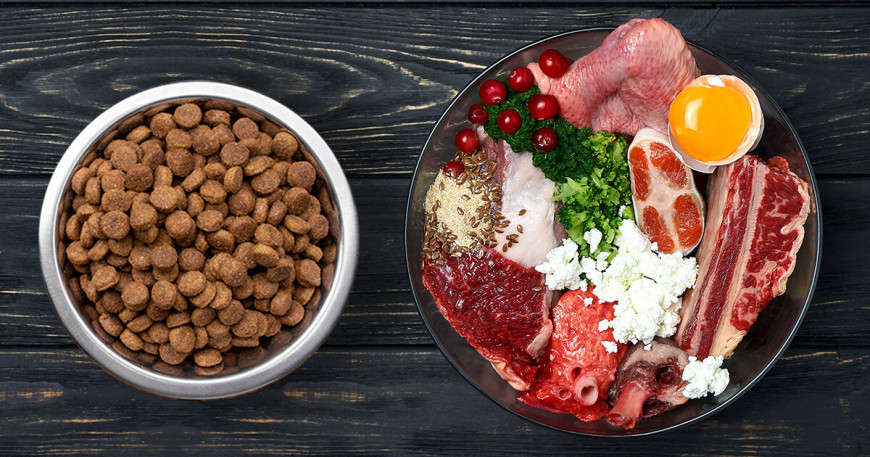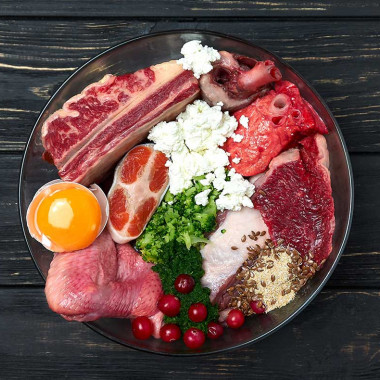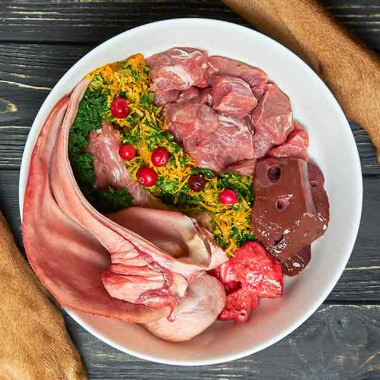Switching to BARF and starting with it may seem complicated, but with the right tips and advice on feeding raw food, you will find it easier than it initially seemed. Whether you are a beginner or advanced, information about transitioning to BARF, the difference between BARF and kibble, or what types of meat to feed when transitioning to BARF, will always come in handy. For easier navigation through products, you can click on the specific highlighted words in the article and start shopping immediately. Or you can click on this link, where you can choose from a complete range of raw feeding meats.
Difference Between BARF and Kibble
Unlike kibble, raw food offers the ability to precisely monitor and change components in the diet. You can quickly identify types of meat that cause allergic reactions, what meat doesn’t sit well with your dog's stomach, or adjust the nutritional value of the meal so the dog doesn’t feel hungry during a diet, or on the contrary, gain weight.
It’s not recommended to feed kibble together with raw meat. Occasional mixing won’t cause problems, but long-term feeding of such a mix can lead to digestive issues. Meat takes up to 24 hours to digest, while kibble can take up to 3 days.
When it comes to food allergies, dogs are often allergic to secondary components in kibble that may not even be listed on the packaging.
When feeding raw food, it's more important to be cautious with side dishes than with the meat itself. Certain types of side dishes, like oats, contain large amounts of phosphorus and may also harbor dangerous mites.
Side dishes should not contain onions, grapes with seeds, apple cores, or avocado pits. However, dogs can consume almost all fruits by themselves—apples, pears, tomatoes, lettuce, cucumbers... Garlic is also suitable in smaller amounts as a preventative antiparasitic.
Other suitable supplements include coconut oil, herbs like milk thistle, and rosehip powder to boost the immune system.
Transition to BARF and Starting with BARF
The transition process (switching to BARF) takes about 2 weeks. During this time, the dog receives a few basic types of meat, such as 5 days of chicken, 5 days of beef, and 5 days of game… This type of diet is called a monoprotein diet (feeding with one type of protein) and serves to detect possible allergies or as a feeding method for dogs with confirmed allergies. These two weeks should consist of pure muscle meat without bones or organs. You can add side dishes like lettuce, spinach, or apples...
After about two weeks on pure meat, ground bones can be introduced. Ground bones help the dog's digestive system get used to processing bones. This should last for about 7-10 days. Vegetables and fruits can still be added. After about 3 to 4 weeks in total, you can start giving whole bones for the first time. If you want to be sure the dog can digest the bones, you can crush them with a meat tenderizer. Once the dog digests bones well, organs can be introduced.
From this point, the dog can enjoy a full BARF diet.
For brachycephalic breeds (breeds with short noses like French bulldogs, pugs…), we recommend sticking to ground bones or providing bones larger than the dog can eat—bones for chewing.
Basics of BARF
The foundation of BARF is knowing how to calculate the right feeding portion for your dog.
It is generally accepted that puppies receive about 4-6% of their ideal current weight, while adult dogs receive about 2-3% of their ideal weight.
Less active dogs receive smaller portions than active dogs. Dogs under stress or those working should receive larger feeding portions made up of energy-rich meats and high-energy side dishes.
If your dog starts losing or gaining weight rapidly, the feeding portion needs to be adjusted.
In the case of diarrhea, changes in urine color, vomiting, itching, redness of the skin, or other problems, the first step should be reviewing what the dog consumed in the last 36 hours and then setting up the necessary diet. For diarrhea, do not administer activated charcoal—it could mask potential blood in the stool.
Example
Let’s take an example of a dog that will thrive on a feeding portion of 2.5% of its weight. So, if the dog currently weighs 20 kg and should weigh about 20 kg, the feeding portion is calculated like this: 20 kg ÷ 100 × 2.5 = 0.500 kg/day.
Then you divide the 500 g into the components of a BARF meal. You don’t have to measure it exactly in grams, and every BARF feeder will tell you something slightly different that suits their dog.
In general, the feeding portion is divided as follows:
50% meat (about 250 g of meat)
30% bones (about 150 g of bones)
10% organs (about 50 g of organs)
10% side dishes (about 50 g of side dishes)
With such proportions, the dog will get a sufficient amount of all nutrients. However, every dog is unique in its feeding, activity level, etc.
The feeding portion doesn’t need to contain all components in one day. You can balance it over a week or two.
If you calculate the above amounts over a month, the dog should eat about 15 kg of meat, bones, organs, and side dishes per month (over 30 days), which looks something like this:
7.5 kg of meat
4.5 kg of bones
1.5 kg of organs
1.5 kg of side dishes
It’s important to ensure the dog gets these volumes of all components over a month. Based on this calculation, you can precisely determine how large your order should be. You can find all the meat, bones, organs, and side dishes on our online store.










